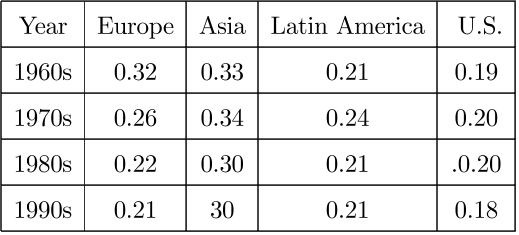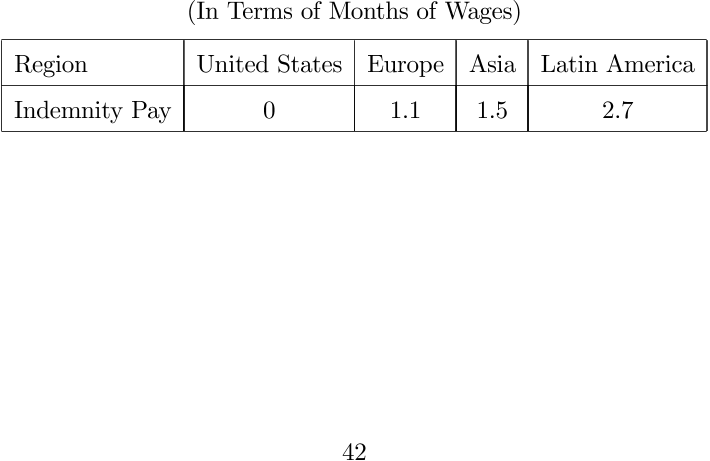Latin America in the rearview mirror
Harold L. Cole,Harold L. Cole,Lee E. Ohanian,Lee E. Ohanian,Lee E. Ohanian,Alvaro Riascos,James A. Schmitz +6 more
Reads0
Chats0
TLDR
This paper found that Latin American countries are the only Western countries that are poor and that are not gaining ground on the U.S. due to TFP differences, and that this failure is not plausibly accounted for by human capital differences, but rather reflects inefficient production.About:
This article is published in Journal of Monetary Economics.The article was published on 2005-01-01 and is currently open access. It has received 179 citations till now. The article focuses on the topics: Latin Americans & Total factor productivity.read more
Figures

Table 6. Investment-to-Output Ratios by Region (Regional Averages for Selected Countries) 
Table 4. Employment Rates by Region (Regional Averages for Selected Countries) 
Table 7. Bils-Klenow Relative Human Capital Levels (Regional Averages for Selected Countries, U.S. = 100) 
Table 5. Capital-to-Ouput Ratios by Decade Average Relative to the U.S.* 
Table 10. Government Ownership Share of the Top 10 Banks 
Table 11. Mandated Severance Pay
Citations
More filters
Posted Content
Distortions, Infrastructure and Labor Supply in Latin American Countries
TL;DR: In this article, the authors studied differences in labor supply between a set of Latin American countries and the U.S, in the period 1990-2005, and concluded that the price of household appliances and access to infrastructure are quantitatively important in explaining cross-country labor supply differences.
Posted Content
Relative Stagnation alla Turca
Tasso Adamopoulos,Ahmet Akyol +1 more
TL;DR: In this paper, the authors argue that Turkey's relative stagnation over the past 50 years is due to: (1) the relative decline in its labor force participation, and (2) a relative stagnation of its TFP.
DissertationDOI
Essays on infrastructure, female labor force participation and economic development
TL;DR: In this article, the authors investigate the role of public capital in development accounting and find large differences in both types of capital across countries, and find that differences in private capital are larger than the ones for total capital for the richest and poorest countries.
Posted ContentDOI
On the Development Gap between Latin America and East Asia: Welfare, Efficiency, and Misallocation
TL;DR: In this paper, the authors used a series of numerical decompositions to study the development gap between Latin America and East Asia and found that the differences in welfare-adjusted development between the two regions are larger than those predicted by per-capita GDP.
References
More filters
ReportDOI
Economic Growth in a Cross Section of Countries
TL;DR: For 98 countries in the period 1960-1985, the growth rate of real per capita GDP is positively related to initial human capital (proxied by 1960 school-enrollment rates) and negatively related to the initial (1960) level as mentioned in this paper.
Journal ArticleDOI
Why Do Some Countries Produce so Much More Output Per Worker than Others
TL;DR: This paper showed that differences in physical capital and educational attainment can only partially explain the variation in output per worker, and that a large amount of variation in the level of the Solow residual across countries is driven by differences in institutions and government policies.
Journal ArticleDOI
Why do Some Countries Produce So Much More Output Per Worker than Others
Robert E. Hall,Charles I. Jones +1 more
TL;DR: This article showed that the differences in capital accumulation, productivity, and therefore output per worker are driven by differences in institutions and government policies, which are referred to as social infrastructure and called social infrastructure as endogenous, determined historically by location and other factors captured by language.
Journal ArticleDOI
Technology, Geography, and Trade
Jonathan Eaton,Samuel Kortum +1 more
TL;DR: This article developed a Ricardian trade model that incorporates realistic geographic features into general equilibrium and delivered simple structural equations for bilateral trade with parameters relating to absolute advantage, comparative advantage, and geographic barriers.
Journal ArticleDOI
The Regulation of Entry
TL;DR: In this article, the authors present new data on the regulation of entry of start-up firms in 85 countries, covering the number of procedures, official time, and official cost that a startup must bear before it can operate legally.
Related Papers (5)
Why do Some Countries Produce So Much More Output Per Worker than Others
Robert E. Hall,Charles I. Jones +1 more